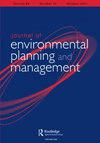产业集聚、环境保护与经济高质量发展:来自黄河流域城市的证据
IF 3.6
4区 经济学
Q1 DEVELOPMENT STUDIES
Journal of Environmental Planning and Management
Pub Date : 2023-10-10
DOI:10.1080/09640568.2023.2260556
引用次数: 0
摘要
摘要中国经济进入了一个新的发展阶段,但生态环境问题继续制约着经济发展的质量。同时,产业集聚的外部性被认为是促进经济高质量发展的必要条件。本文提出了一个考察产业集聚、环境保护与经济高质量发展之间关系的理论框架。以黄河流域城市为研究对象,采用空间计量模型对假设进行验证。最后得出如下结论。首先,产业集聚与高质量经济发展、环境保护与高质量经济之间存在显著的u型曲线关系。产业集聚对环境保护具有重要的促进作用。经济高质量发展在两种空间权重矩阵下均表现出空间溢出效应,而产业集聚和环境保护仅在地理距离空间权重矩阵上表现出空间溢出效应。最后,文章提出城市应加快产业集聚程度,以达到促进环境保护和经济高质量发展的双重效果。此外,各国政府在促进生态保护和经济高质量发展时,应特别注意建立区域间的协同机制。关键词:产业集聚环境保护经济高质量发展空间计量经济模型黄河流域城市作者贡献臧千文:概念、方法、调查、撰写—初稿、软件、形式分析、撰写—审编、项目管理、验证、可视化;薛伟贤:资源、资金获取、监管。披露声明作者声明,他们没有已知的竞争经济利益或个人关系,可能会影响本文所报道的工作。数据可用性手稿中描述的材料将免费提供给任何希望用于非商业目的的研究人员,而不会违反参与者的保密义务。注1本文以太原、大同、阳泉、长治、晋城、朔州、晋中、运城、忻州、临汾、吕梁、呼和浩特、包头、乌海、鄂尔多斯、巴彦淖尔、乌兰察布、济南、淄博、东营、济宁、泰安、德州、聊城、滨州、郑州、开封、洛阳、安阳、鹤壁、新乡、焦作、铜川、濮阳、三门峡、西安、铜川、宝鸡、菏泽、西宁、渭南、延安、榆林、商洛、兰州、白银、天水、武威、平梁、庆阳、定西、陇南、银川、石嘴山、吴中、固原、中卫。项目资助:国家自然科学基金项目[批准号:72273103];陕西省自然科学基金重点项目[批准号2022JZ-41]本文章由计算机程序翻译,如有差异,请以英文原文为准。
Industrial agglomeration, environmental protection, and high-quality economic development: evidence from cities along the Yellow River Basin of China
AbstractChina’s economy has entered a new phase of development, but ecological and environmental issues continue to hinder the quality of economic development. Meanwhile, the externalities of industrial agglomeration are seen as essential for promoting high-quality economic development. This article proposes a theoretical framework to examine the relationship between industrial agglomeration, environmental protection, and high-quality economic development. Using cities along the Yellow River Basin as the research object, a spatial econometric model is employed to verify the hypothesis. Ultimately, the conclusions are as follows. First, there is a significant U-shaped curve relationship between industrial agglomeration and high-quality economic development, as well as between environmental protection and a high-quality economy. Industrial agglomeration plays a significant role in promoting environmental protection. Second, high-quality economic development exhibits spatial spillover effects under both spatial weight matrices, while industrial agglomeration and environmental protection only show spatial spillover effects based on geographical distance spatial weight matrices. Finally, the article suggests that cities should accelerate the degree of industrial agglomeration to achieve the dual effect of promoting environmental protection and high-quality economic development. Additionally, governments should pay special attention to inter-regional synergistic mechanisms when fostering ecological protection and high-quality economic development.Keywords: industrial agglomerationenvironmental protectionhigh-quality economic developmentspatial econometric modelcities along the Yellow River Basin Author contributionsQianwen Zang: conceptualization, methodology, investigation, writing – original draft, software, formal analysis, writing – review and editing, project administration, validation, visualization; Weixian Xue: resources, funding acquisition, and supervision.Disclosure statementThe authors declare that they have no known competing financial interests or personal relationships that could have appeared to influence the work reported in this article.Data availabilityMaterials described in the manuscript will be freely available to any researcher wishing to use them for non-commercial purposes, without breaching participant confidentiality.Notes1 This paper focuses on 57 cities in China, including Taiyuan, Datong, Yangquan, Changzhi, Jincheng, Shuozhou, Jinzhong, Yuncheng, Xinzhou, Linfen, Lvliang, Hohhot, Baotou, Wuhai, Ordos, Bayannur, Ulanqab, Jinan, Zibo, Dongying, Jining, Tai’an, Dezhou, Liaocheng, Binzhou, Zhengzhou, Kaifeng, Luoyang, Anyang, Hebi, Xinxiang, Jiaozuo, Tongchuan, Puyang, Sanmenxia, Xi’an, Tongchuan, Baoji, Heze, Xining, Weinan, Yan’an, Yulin, Shangluo, Lanzhou, Baiyin, Tianshui, Wuwei, Pingliang, Qingyang, Dingxi, Longnan, Yinchuan, Shizuishan, Wuzhong, Guyuan, and Zhongwei.Additional informationFundingThis work was supported by the National Natural Science Foundation of China Projects [grant number 72273103]; Key project of Shaanxi Provincial Natural Science Foundation [grant number 2022JZ-41]
求助全文
通过发布文献求助,成功后即可免费获取论文全文。
去求助
来源期刊
CiteScore
9.10
自引率
5.10%
发文量
155
期刊介绍:
Journal of Environmental Planning and Management has already established itself as a leading forum for up-to-date scholarly but accessible papers on all aspects of environmental planning and management. With contributions from leading international authors, the Journal publishes influential, high quality papers -an essential feature whether you are a subscriber, reader, contributor or all three. The Editors and International Editorial Advisory Board are drawn from around the world and are committed to encouraging researchers and practitioners to contribute to multidisciplinary and international debate in the field. The central aim is to focus on the integrated planning and management of the environment.

 求助内容:
求助内容: 应助结果提醒方式:
应助结果提醒方式:


